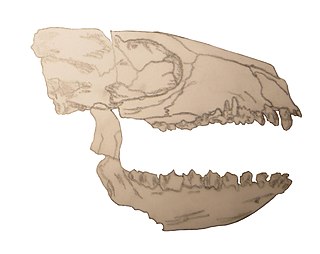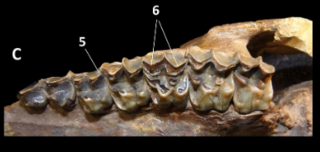
Cramauchenia is an extinct genus of litoptern South American ungulate. Cramauchenia was named by Florentino Ameghino. The name has no literal translation. Instead, it is an anagram of the name of a related genus Macrauchenia. This genus was initially discovered in the Sarmiento Formation in the Chubut Province, in Argentina, and later it was found in the Chichinales Formation in the Río Negro Province and the Cerro Bandera Formation in Neuquén, also in Argentina, in sediments assigned to the SALMA Colhuehuapian, as well as the Agua de la Piedra Formation in Mendoza, in sediments dated to the Deseadan. In 1981 Soria made C. insolita a junior synonym of C. normalis. A specimen of C. normalis was described in 2010 from Cabeza Blanca in the Sarmiento Formation, in sediments assigned to the Deseadan SALMA.
Victorlemoinea is an extinct litoptern genus of the family Sparnotheriodontidae, that lived from the Early to Middle Eocene. Fossils of Victorlemoinea have been found in the Las Flores, Sarmiento and Koluel Kaike Formations of Argentina, the Itaboraí Formation of Brazil and La Meseta Formation, Antarctica.

Astrapotheria is an extinct order of South American and Antarctic hoofed mammals that existed from the late Paleocene to the Middle Miocene, 59 to 11.8 million years ago. Astrapotheres were large, rhinoceros-like animals and have been called one of the most bizarre orders of mammals with an enigmatic evolutionary history.
Ernestokokenia is an extinct genus of mammal, belonging to the Didolodontidae. It lived during the Early Eocene and the Middle Eocene, and its fossils were discovered in South America.

Eoastrapostylops is an extinct genus of astrapothere that lived during the Late Paleocene in what is now Argentina.
Asmithwoodwardia is an extinct genus of mammals, from the order Litopterna. It lived during the Late Paleocene and the Early Eocene, and its fossilized remains were found in South America.
Protolipterna is an extinct genus of mammal, belonging to the order Litopterna. It lived during the Late Paleocene and the Early Eocene, in what is now South America.
Polymorphis is an extinct genus of litopterns belonging to the family Macraucheniidae. It lived during the Middle Eocene of Argentina.
Adianthus is an extinct genus of litoptern that lived during the Early Miocene to the Middle Miocene in what is now Argentina and Chile.
Proadiantus(Ameghino, 1897) is an extinct genus of adianthid litoptern. It lived during the Late Oligocene, in what is today South America. It consists of only 1 species, Proadiantus excavatus.
Thadanius is an extinct genus of Litoptern, belonging to the family Adianthidae. It lived during the Late Oligocene, in what is today Bolivia.

Adiantoides is an extinct genus of herbivorous mammal, belonging to the order Litopterna. It lived during the Middle to Late Eocene, in South America.
Notonychops is an extinct genus of mammal, belonging to the order Litopterna, that lived during the Middle to Late Paleocene in what is today South America.

Anisolambda is an extinct genus of litoptern. It lived from the Late Paleocene to the Middle Eocene in what is now Argentina.
Proectocion is an extinct genus of adianthid litoptern. It lived during the Early Eocene, in what is now South America.

Protheosodon is an extinct genus of proterotheriid litoptern. It lived from the Late Oligocene to the Early Miocene in what is now Argentina and Colombia.
Xesmodon is an extinct genus of mammal. It lived from the Middle to the Late Eocene, in what is today South America.

Tetramerorhinus is an extinct genus of proterotheriid litoptern that lived during the Early and Middle Miocene in what is now Argentina and Peru.
Eurygenium is an extinct genus of notoungulate belonging to the family Notohippidae. It lived during the Late Oligocene in what is today South America.
Guilielmofloweria is an extinct genus of proterotheriid litoptern that lived from the Middle to Late Eocene of what is now Argentina. Fossils have been found in the Sarmiento Formation of Argentina.















